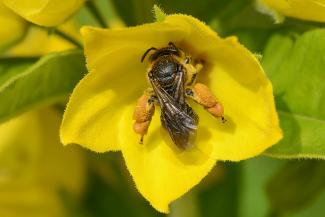
Image Credit: Jürgen Mangelsdorf
Oil-collecting Bees (Melittidae: Macropis)
These bees belong to the non-diverse family Melittidae, found principally in South Africa; there are 3 genera and 25 species in North America. These bees visit plants that produce liquid oils or solid waxes and not nectar. The genus Macropis in North America is an oil-gather (they specialize on the genus Lysimachia in the loosestrife family), the other two rarely observed genera have switched to nectar-producing plants. Our Macropis species can be easily recognized by their huge hindlegs, the basitarsi of which are adapted to “sponge up” the oil for transport to the nest for both larval carbohydrate and nest wall water-proofing. The oil is initially harvested by unique spongy hairs on the bottom surface of the front and middle feet. There are 4 species of Macropis in North America. Macropis dig shallow nests in bare streambanks adjacent to the host plants; the gregarious nests are only several inches deep and the burrows are re-used for several years (>25 nests in a 3x3 inch square!).
There are 2 endangered species of Hesperapis associated with heliotrope in western Washington, and the possibility of the very abundant California specialist on California poppy (Eschscholzia) in southern Oregon. Melitta is found in the west only along the Mexican border in California. These species would resemble Andrena, even to the professional scientist.


In several genera of bees of the PNW, the males are distinguished by their yellow facial markings. This is an easy character to see. Notice that Macropis is characterized by transverse posterior abdominal hair bands (“fasciae”). Notice also the huge swollen hind legs of the male.

Macropis is a specialist on loosestrife flowers for oil and pollen; it visits a wide variety of flowers for nectar for adult flight energy. Notice the HUGE pollen baskets (“scopae”) and the portion wetted down with oil. The oil is used to waterproof the nest, and to feed the larvae instead of nectar. Notice how she holds her scopae (pollen transport structures) out of the way as she is harvesting more oil.